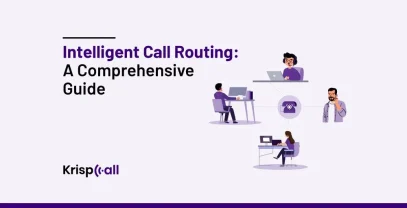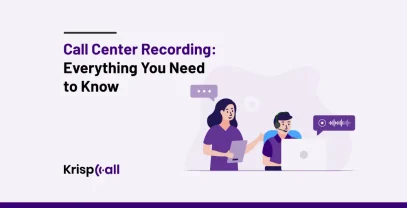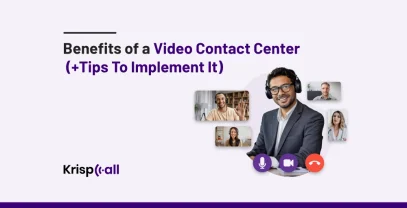How do you perceive the balance ⚖️ between inbound and outbound calls regarding customer engagement and business objectives? Both inbound and outbound calls 📞 are equally crucial for contact centers to deliver satisfactory customer service.
Considering the diverse preferences of today’s customers, organizations need to offer a personalized and consistent experience across all communication channels.
A blended contact center can better solve this modern business requirement. But what does it take to set up a blended contact center?
In this guide, we’ll discuss what a blended contact center is, provide a step-by-step guide📋 to setting one up, discuss various advantages, and discuss the best practices for effective blended contact centers.
🔑 KEY HIGHLIGHTS:
- A blended contact center is a customer service center that handles both inbound and outbound calls.
- Some advantages of a blended contact center include increased revenue, enhanced customer satisfaction, increased productivity and efficiency, cost-efficacy, and data-driven decision-making.
- Extensive agent training, implementing robust technology, monitoring and improving performance, and effectively using CRM systems are some of the best practices for effective blended contact centers.
- A step-by-step process for setting up a blended contact center includes selecting robust software, determining goals and objectives, setting up skill-based routing and agent profiles, and so on.
What is a Blended Contact Center?
A blended contact center is a customer care center or a call center that handles both inbound and outbound calls. These centers are usually well-prepared to manage incoming and outgoing calls from anywhere within the organization.
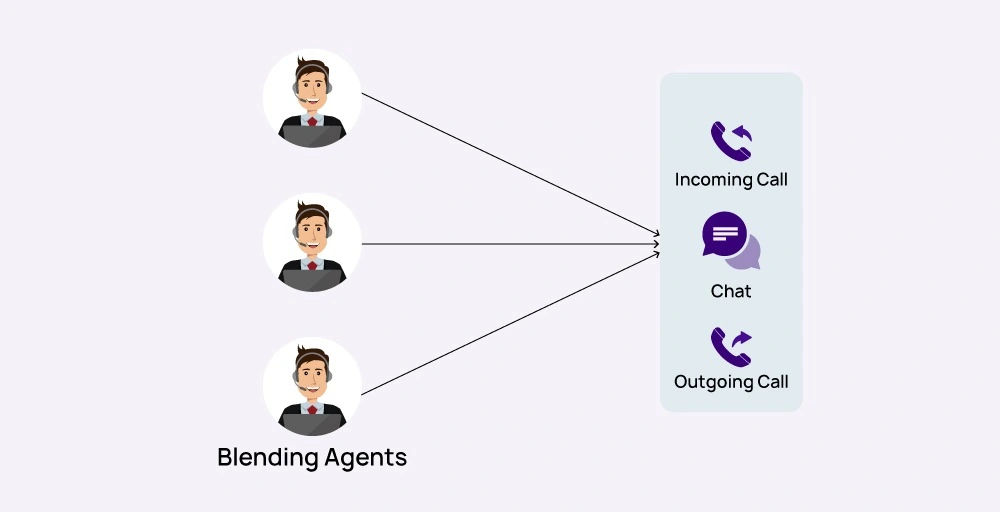
Activities like inbound and outbound communication, which include integrated data, are imperative for companies’ beneficial operations from remote locations. The role handling inbound and outbound calls plays in increasing total sales, simplifying operations, and hence facilitating ever-higher levels of customer satisfaction can’t be overlooked. This helps you dynamically allocate agents to inbound and outgoing calls based on call demand.
A firm can effortlessly interact with its clients via chat, email, and telephone and simultaneously solve their needs in various other channels. For instance, call centers that do outbound selling calls or surveys build client dependency on proactive contact, while the direct evidence is that a company runs such businesses.
Let’s take an Internet service provider (ISP), as an example. They employ a blended contact center that includes an input channel for customer’s inquiries and complaints, technical support, and an output channel for promotional services such as a new service package or marketing campaign.
What are the Advantages of Blended Contact Center?
Businesses use a blended contact center to respond to queries, assist customers, and address issues promptly. A blended contact center offers both inbound and outbound calls. It maximizes the use of resources so companies can advertise their products and services, provide exceptional customer service, and thus enhance productivity.
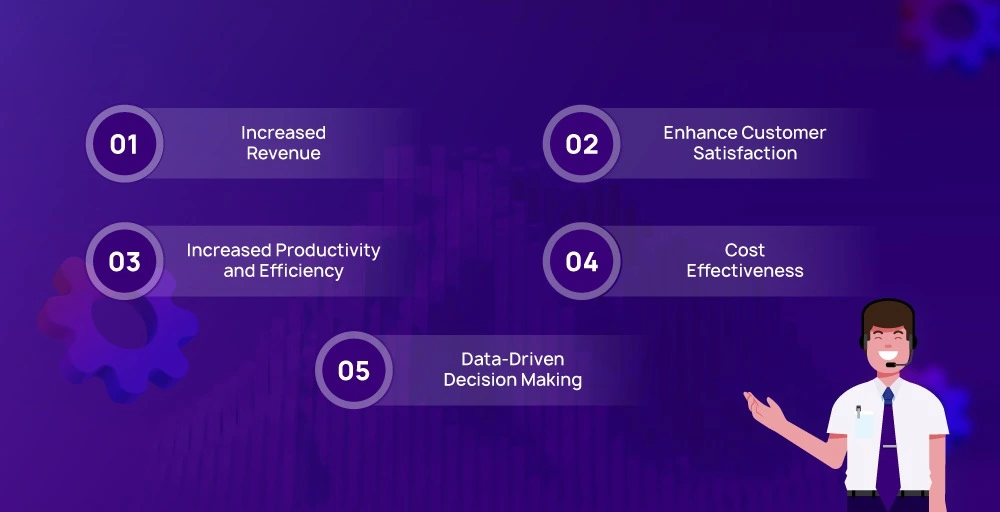
The blended contact center helps agents manage customer interactions effectively and offers numerous advantages by integrating both inbound and outbound calls. Some of the significant advantages of the blended contact centers are:
1. Increased Revenue
Blended contact centers combine inbound and outbound call agents to create more ways for upselling and cross-selling, leading to increased sales. This makes it more likely that consumers will follow the advice of the same combination of agents during their inbound and outbound calls.
Agents using outbound calling can prospect leads, start campaigns for selling, and contact potential customers on their initiative. This would give you an edge ahead of rivals, supporting your sales activities.
2. Enhance Customer Satisfaction
Blended contact center platforms have enabled agents to contact clients regularly through chat, calls, and customized script tools.
High customer satisfaction is guaranteed as availability is 24/7; hence, issues are solved quickly. Thus, quick responses are given to customer inquiries, which would satisfy the customer.
3. Increased Productivity and Efficiency
With the help of blended contact center solutions, agents can easily switch between incoming and outgoing calls without difficulty, give calls to skilled agents, and use remote workers as needed.
This method reduces customer waiting periods and aids agents in answering more calls as their efficiency increases due to the high volume of calls handled. In this way, all the agent’s time is effectively optimized, leading to improved productivity.
4. Cost-Effectiveness
Instead of having separate departments and entities, businesses can combine their incoming and outgoing flows, which leads to joint infrastructure and decreased hardware and maintenance costs.
Furthermore, agents can switch over and engage in an outbound program during the intervals when there are no incoming calls. Once again, small startups are squeezed, so they should reconsider utilizing CRM systems and data analysis, ensuring a more creative and cheaper strategy, well-managed operations, and cost-effective decisions.
5. Data-Driven Decision Making
Having a blended contact center involves the combination of CRM, information systems, and analytics apps to study and analyze the information about customers who make contact.
This method enables organizations to discover market tendencies, streamline procedures, and take any action that they deem necessary or helpful. The information and data from such systems may lead to lower-cost plan design and improved operational functioning.
Best Practices for Effective Blended Contact Centers
A customer service center that utilizes blended contact cares for clients by developing specialized arrangements and plans in order to enhance client satisfaction and well-being. Hence, being in touch with the requirements and prevailing practices in the sector will lead to effective blended contact center outcomes.
Some of the best practices for effective blended contact centers are:
- Extensive agent training: The managers must ensure that the contact center agents are adequately trained to deliver a pleasurable blended contact center service to the customers. To attain this objective, you may consider promoting learning through mentorship and adopting assisting care among the workers.
- Implement robust technology: You can invest in call center software with capabilities for omnichannel, interactive voice response (IVR), predictive dialing, and automated call distribution (ACD). The right technology can reduce queue time and ensure efficient call routing.
- Performance monitoring and improvement: One critical process in evaluating customer service effectiveness is frequently following essential performance indicators (KPIs), client feedback, and agent performance. This could help increase productivity and enable customers to meet their expectations for all services. You can name the points for improvement and give recommendations and criticisms.
- Provide agents with comprehensive customer data: This is achieved by empowering them to cast their vision over call logs, customer details, and interaction history from any communication channel or interaction. Thus, they can freely communicate with customers and customize communication according to the individuals’ interaction history. This allows them to personalize their web interactions, form solid relationships, and resolve any concerns faster.
- Personalized customer interactions: One fundamental principle blended contact centers must implement is to engage with their customers one-on-one. You must prioritize using CRM systems, partial automation, and AI applications to ease personalized customer interaction processes.
- Set clear performance metrics: Establish vital indicators and measure customer satisfaction, call rate, and average handle time to monitor performance. Assess measures often to identify improvement areas and make the working process more efficient.
- Use CRM systems effectively: You must connect your blended contact center with CRM systems to access client data in real-time. By having an overall view of every customer’s data and information in the system, the agents can then ensure they engage customers in tailored conversations across all channels.
How to Set up Blended Contact Centers?
Setting up a blended contact center requires analyzing several key factors, such as investing in the infrastructure, integrating CRM systems, implementing workload management tools, etc. These factors should be prioritized to implement successful blended contact centers.
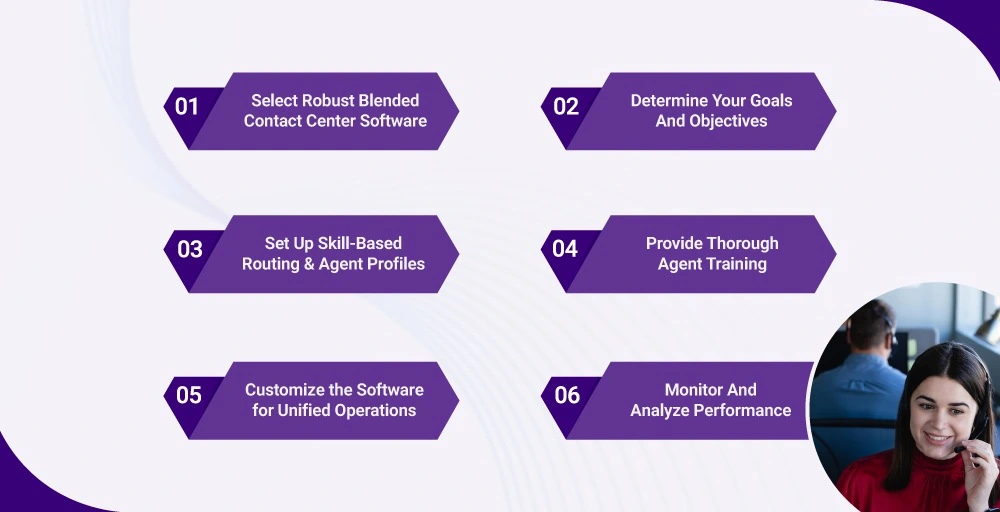
Here is a brief step-by-step process for setting up a blended contact center:
1. Select Robust Blended Contact Center Software
You may opt for a call center software option such as KrispCall; it has good features and can be used for either inbound or outbound calls. Moreover, your existing systems, including CRM, should be integrated, and your workflow management should be followed.
2. Determine Your Goals And Objectives
First, select the contact center software that you want to implement. Next, communicate and determine what the blended contact center offers to help you achieve your set objectives and goals. Manage to distinguish the appropriate strategy that could strengthen your customer service so you may enjoy increased revenue.
3. Set Up Skill-Based Routing and Agent Profiles
Gather a team of agents who are skilled enough to perform inbound and outbound calls as needed. Create profiles for agents with their names, identification numbers, emails, and skill sets. Set up call routing workflows for calls to be directed to the most suitable agent according to the pre-established criteria.
4. Provide Thorough Agent Training
Provide agents with needed skills by offering them comprehensive training on the software features, stress management, communication, and selling techniques. Offer regular training sessions to motivate continuous growth for the agents who seem to be performing poorly.
5. Customize the Software for Unified Operations
Customize your software in a manner that suits your specific necessities as well as operational workflow demands. You must ensure that your customer relationship management (CRM) system is integrated so the agents can access all the customer data and tools in one centralized location.
6. Monitor And Analyze Performance
You must be attentive to important performance indicators, considering the sales conversion rates and timeframes within which issues should be resolved. You must identify improvement areas and track scorecards while monitoring agents’ performance in real time to provide immediate feedback and coaching.
Wrapping Up
If your business handles incoming and outgoing calls separately, you must spend a lot without any benefits. Meanwhile, in a blended contact center, both inbound and outbound calls are combined so that you can share complete customer insight, hence saving on costs and operational inefficiencies.
Setting up a blended contact center with the proper software that matches your requirements and goals is a must. KrispCall, a telephony system that provides a seamless blended call center experience, can be a great choice as it offers various features that help to improve customer interaction and enhance customer satisfaction.
Implementing best practices in the system may lead to higher agent productivity, lower operating costs, and better customer experiences in blended contact centers.
FAQs
1. What are the challenges in the Blended Contact Center?
The challenges in the blended contact center include seamlessly managing channel transitions, maintaining consistent service quality across channels, and ensuring that agents are proficient in handling diverse communication methods.
2. What is the main difference between Blended Contact Center and Blended Call Center?
The main difference between a blended contact center and a blended call center is that a blended contact center supports a broader range of communication channels like Email, SMS, Social Media, Live Chat, etc, beyond voice calls, unlike a blended call center.
3. Can Blended Contact Center integrate with various CRM systems?
Yes, a blended contact center can integrate with various CRM (Customer Relationship Management) systems that streamline customer interactions across different channels and maintain a unified view of customer data.
4. What is a Blended Agent?
A blended agent is a customer service representative trained and equipped to handle interactions across multiple communication channels, such as voice calls, emails, chats, and social media messages.



